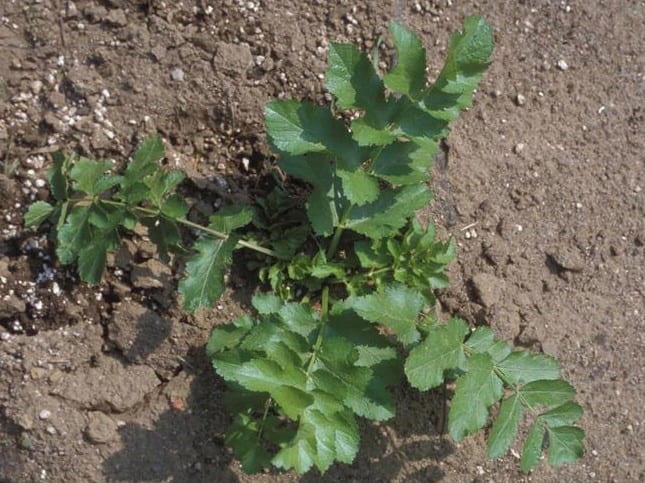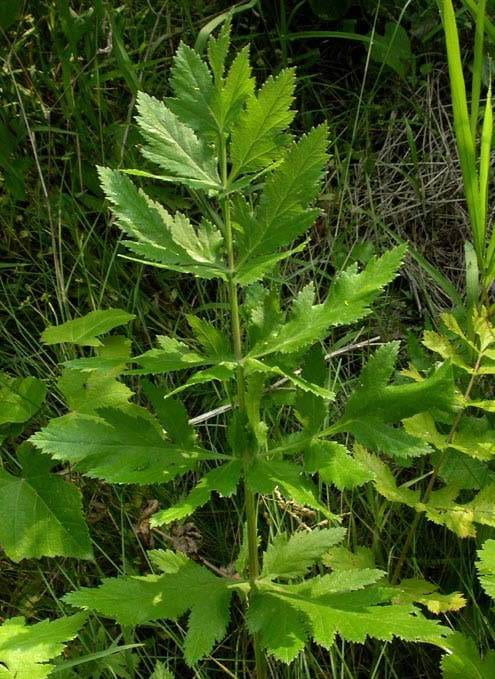Wild parsnip (Pastinaca sativa) is an herbaceous, biennial/perennial, invasive plant. This plant can thrive in a wide range of environmental conditions from dry to wet soils. Wild parsnip most commonly invades areas with disturbed soils. It is commonly found throughout New York growing in pastures, abandoned fields, and along roadsides. Additionally, this plant can become highly problematic in u-pick operations. Due to its threat to human health, it is important that this plant is recognized.
Toxicity
When exposed to skin, wild parsnip sap causes phytophotodermitis, or a chemical burn from increased sensitivity to sunlight. The compound causing it in the sap, furanocoumarin, is produced within all the aboveground plant parts including leaves, stems, flowers, and fruits. Essentially, the condition causes a severe sunburn. This reaction results in intense burning, blistering, skin discoloration, and/or rashes with symptoms varying based on the exposure and the individual sensitivity. Symptoms of exposure to wild parsnip can last up to two years. If exposed to wild parsnip, cover the affected area immediately to prevent the reaction and wash the area with warm water and mild soap. The exposed area will continue to be sensitive for around 8 hours after exposure and should be kept covered. If working in wild parsnip, be sure to cover all areas that may be exposed to sap by wearing long sleeves, pants, and gloves. Make sure if pulling wild parsnip to cover the wrist area where gloves and long sleeves may not cover. If exposed to sap and blisters start to form, cover the area with a cool wet cloth and keep it away from sunlight. In addition to being a skin irritant, both wild parsnip and its seeds are toxic if ingested by livestock and should be managed within pastures. Burns on the skin can occur after ingestion when the furanocoumarins are in blood vessels of animals.

Wild parnsip burns. Image by Andrew Link, Lacrosse Tribune 2013 via New York Invasive Species Information
Identification
Seedlings: Wild parsnip seedlings emerge from February through April. Seedlings have small ovate leaves at first on long stalks. The seedling leaves are toothed and a yellowish-green color.
Leaves: Wild parsnip leaves have a yellowish-green color. They have compound leaves, in other words, it has a central stem with 3-5 leaflets coming off of it. Leaflets are toothed with a diamond-like shape. Leaves range in size from 6 to 12 inches. Lower leaves have short stems while those higher on the stem are stemless.
Mature plant: Like its leaves, wild parsnip stems also have a yellowish-green color. Stems have vertical grooves running up and down the stems. They are hollow throughout the plant but not at the nodes. Because wild parsnip is a biennial, it takes at least two growing seasons for the plant to reach maturity. In the first year (sometimes in addition to the second year), the plant only produces a rosette. These rosettes are low-growing clusters of compound leaves ranging from 5 to 15 inches. In the second or third year, wild parsnip produces its flowers and seeds. In the flowering stage, wild parsnip can grow to be up to 5 feet tall. After the flower produces seeds, it dies and the dead stalk will remain standing.
Flower/seeds: Wild parsnip have flower stalks with a flat-topped umbel of clustered yellow terminal flowers. There is one main flower stalk with secondary and tertiary umbels of flowers branching off the main stem. Each tiny flower in the umbel has five petals. Wild parsnip flowers from early June to mid-July with the flower on the main stem blooming first and the side branched flowers blooming 10-14 days after. This allows the plant to produce seeds over a longer period. Seeds are bright green when first produced but as they mature over three weeks, they turn brown. Seeds have an oval shape and are around ¼ inch long. They are smooth on one side with ribbed edges on the other with narrow wings. Wild parsnip only produces by seed and up to 1000 seeds can be produced by a single plant. Seeds can survive in the soil seedbank for up to 4 years.
Wild parsnip flowers. Image by Virginia Tech Weed ID Guide, via New York Invasive Species Information.
Species Similar to Wild Parsnip
Table 1: Shows wild parsnip (Pastinaca sativa) similarities and differences in identification compared to its similar species .| Species | Similarities | Differences |
|---|---|---|
| Golden Alexander (Zizia aurea) | yellow flowers in clusters | plants are <30 inches tall, consistently toothed leaf margins |
| Giant hogweed (Heracleum mantegazzianum) | flat-topped flowers | white flowers, hairy stems, purple splotches on stems |
Management
Chemical control
Cornell University’s Turfgrass and Landscape Weed ID app offers suggestions for conventional and alternative chemical control options. For an excellent comprehensive guideline to both chemical and non-chemical management of wild parsnip, please see Management of invasive plant in Wisconsin: Wild Parsnip published by the University of Wisconsin-Madison.
Non-chemical control
There are various non-chemical management techniques that can be used for controlling wild parsnip. Hand pulling can be effective for small populations, especially if done when the soil is moist. Mowing is another effective management treatment if timed correctly. Mowing should be carried out after flower emergence but before the plants go to seed. This depletes the plant’s energy, so it is unable to grow back that season. Mowing should be repeated at the same time annually. After 3-5 years, wild parsnip populations will be reduced. Additionally, prescribed burning and planting vigorous native species can help to control wild parsnip. For an excellent comprehensive guideline to both chemical and non-chemical management of wild parsnip, please see Management of invasive plant in Wisconsin: Wild Parsnip published by the University of Wisconsin-Madison.
References
Cornell University’s Cornell Fruit Resources: Berries. New and Emerging Pest Issues in Berries- Wild Parsnip https://blogs.cornell.edu/berries/ipm/pest-alerts/wild-parsnip/
Cornell University’s Turfgrass and Landscape Weed ID app. Identification and control options for weeds common to turf, agriculture, and gardens in New York; uses a very simple decision tree to identify your weed. http://turfweeds.cals.cornell.edu/plant/control/150
Cornell University’s Turfgrass and Landscape Weed ID- Weeds and Human Health: The Severe Seven http://turfweeds.cals.cornell.edu/weeds-and-human-health
Cornell University’s Weed Ecology and Management website. Contains a wealth of information on ecological management of agricultural and garden weeds. Look for a revamp of this site in 2021.
Management of invasive plant in Wisconsin-Wild Parsnip by Brendon Panke, Ryan deReginer, and Mark Renz. University of Wisconsin-Madison. 2012. https://portage.extension.wisc.edu/files/2018/04/Wild-Parsnip-Management-A3924-15.pdf
New York Invasive Species (IS) Information- Wild Parsnip http://nyis.info/invasive_species/wild-parsnip/
New York State Department of Environmental Conservation- Wild Parsnip https://www.dec.ny.gov/animals/105364.html
University of Minnesota Extension- Wild parsnip: problem plant in hay and pastures https://extension.umn.edu/horse-pastures-and-facilities/wild-parsnip
Wild Parsnip (Pastinaca sativa): A Major Threat to Wisconsin’s Prairies, Fields and Roadsides by Lia Johnson and David J. Eagan. University of Wisconsin-Madison. 2007. https://portage.extension.wisc.edu/files/2018/04/Wild-Parsnip-Management-A3924-15.pdf








